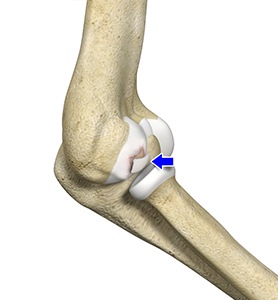
What is Osteochondritis Dissecans (OCD) of the Capitellum?
OCD of the capitellum is a localized fragmentation and separation of subchondral bone - meaning the bone below the cartilage - in your elbow.
Overview of OCD of the Capitellum
Osteochondritis dissecans (OCD) is a painful condition in your elbow joint and occurs at the place where the end of one bone meets the end of another bone. It happens when the subchondral bone surrounding the capitellum of your elbow dies due to lack of blood flow. It results in cracking of the subchondral bone and the underlying cartilage, causing them to separate from the capitellum.
The capitellum is an enlarged knoblike structure on the outer side of the end of the upper arm bone, or humerus. It forms an articulation with another bone in the elbow joint. The capitellum is covered by smooth, slippery connective tissue called articular cartilage.
Subchondral bone is bone that is located just below the articular cartilage and acts as a shock-absorber. It has many blood vessels supplying it with oxygen and essential nutrients.
Types of OCD of the Capitellum
There are two types:
- Stable OCD: Where the elbow will still have a full range of motion
- Unstable OCD: Where the elbow suffers from loss of motion
Who is at Risk of OCD of the Capitellum?
The condition is most common in:
- Children and teens who are very active in sports
- Young athletes engaged in sports that require overhead-throwing such as baseball
- People who repetitively stress their elbow, such as gymnasts or weight-lifters
Causes
The exact cause is unknown. However, you may experience the condition due to:
- Extreme pressure on or overuse of the capitellum resulting in multiple episodes of minor, unrecognized injury
- Repetitive trauma to the capitellum leading to bone damage
- Compromised blood supply to the subchondral bone or capitellum
- Increased valgus load (angled, outward bend) across the elbow joint
- Genetic predisposition
Symptoms
After OCD of the capitellum sets in, the loose bone along with the cartilage may remain in place or can move into the joint area.
Some of the major symptoms of the condition include:
- Pain in the elbow, particularly on the outer aspect or lateral side
- Pain that decreases with rest but increases with activity
- Reduced range of motion in the elbow or difficulty in straightening the elbow fully
Diagnosis
The diagnosis will begin with a detailed physical examination of the affected elbow which involves comparing it to the non-affected elbow.
The condition is then confirmed by imaging such as the following:
- X-ray
- MRI scan
Treatment
Various options are available to treat OCD of the capitellum. However, a specific type of treatment will be chosen depending on the stage and nature of the condition.
If the OCD of the capitellum is in its early stage and stable, conservative treatment involving rest and modification of activities may suffice. This includes total abstention from all sports or sporting activities until the condition is fully healed. In some cases, procedures such as casting, bracing or splinting may be needed.
Surgery will be considered if:
- There is no improvement in the condition after 3 months of rest
- The OCD of the capitellum does not respond to conservative therapy
- The condition is unstable, in which there are loose fragments caught between the moving parts of the joint
The surgical options can be:
- Arthroscopy (minimally invasive approach with good results)
- Internal fragment fixation or loose-body removal
- Autologous chondrocyte grafting (osteochondral autograft transplantation)
- Local debridement, abrasion chondroplasty, closing-wedge osteotomy
Post-Surgery Care and Recovery
After the surgery, you will be advised not to return to any overhead throwing sports or activities until the injury is completely healed, even if motion is restored and pain is absent.
It may take between 4 months to 2 years to fully recover from OCD of the capitellum.
Related Topics
- Elbow Arthritis
- Tennis Elbow
- Golfer's Elbow
- Bicep Tendon Rupture
- Triceps Tendon Rupture
- Elbow Dislocation
- Ulnar Collateral Ligament (UCL) Injury/Tear
- Ulnar Nerve Neuropathy
- Elbow Impingement
- Valgus Extension Overload
- Elbow Injuries
- Triceps Injuries
- Osteochondritis Dissecans of Elbow
- Elbow (Olecranon) Bursitis
- Little League Elbow
- Bicep Tendon Tear at the Elbow
- Osteochondritis Dissecans of the Capitellum
- Triceps Tendonitis
- Radial Head Fractures of the Elbow
- Throwing Injuries
- Lateral Impingement of the Elbow
- Posterior Impingement of the Elbow
- Lateral Ulnar Collateral Ligament Injuries (Elbow)
- Cubital Tunnel Syndrome (Ulnar Nerve Entrapment)
